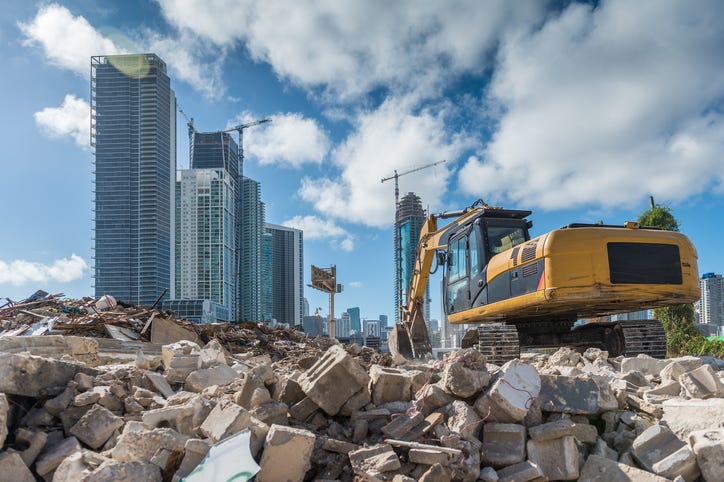Architecture school is a place full of big ideas.
That sounds like a selling point, but what it really means is that it’s a place full of overly-confident 18-to-24-year olds with god complexes swearing that they’re going to change the world. Spend an afternoon sitting through design critiques, and you’ll hear dozens of variations of the same structure of thinking.
My design does (x), and because of that, users will do (y).
This kind of thinking isn’t limited to the dusty halls of architecture studios, mind you, but it’s basically the one shared ethos inside of them, a clear belief that one can orchestrate or even dictate human behavior if only the person doing so is clever enough.
People are predictable, and design can direct them to do predictable things.
Of course, this line of thinking is folly.
People aren’t predictable. They’re complex and contradictory and messy and irrational or rational in ways that make sense to them but not to any outside observer, and anyone foolish enough to ignore this is bound to see their design fail. One of my favorite classes during graduate architecture school focused on Post-Occupancy Evaluation, a sub-practice in design where the successes and failures of buildings are recorded after those pristine designs have gone a few rounds with human nature.
There’s usually more failures than successes, and my enjoyment of this fact likely outs me as a hater.
[shrug]
Guilty.
Big ideas are great at the idea stage, but they often encounter trouble when real people get involved. This is a recurring theme in architecture and urban design—really, much of the 20th century was dedicated to Big Thinkers coming up with Big Ideas that promised to make things Better For Everyone and in fact made them far, far worse. Entire cities were leveled, hollowed out and stripped bare by people who truly thought they were doing the right thing for society. For community.
It is easy to draw a building. It is easy to map out a city.
It is very difficult, however, to build a community, and much more so a vibrant, lively, and sustainable one. It is impossible to do so by fiat. When you destroy one—even with good intentions—it can’t be recreated in a new place.
You can’t rebuild something that never had a plan to begin with.
I’ve been thinking a lot about those Big Thinkers in thinking about the possible demise of Twitter at the hands of Elon Musk.
Admittedly, saying Twitter is over is much like saying rock and roll is dead or that New York City is over—people have been saying it from nearly the moment it began. But while there have been threats to the social media platform’s existence in the past, it’s safe to say none compare to where it is today: a megalomaniacal billionaire buying the company with no apparent plan, saddling it with massive debts, scaring off the advertisers that make up the lion’s share of its revenue, firing half of its employees seemingly at random, and declaring it a haven for ‘free speech’ while banning anyone who makes a joke at his expense.
Taken in that light, it’s something closer to a meteor hurtling toward Times Square than the closing of your favorite dive bar.
One gets the sense that Musk—a man blessed with unfathomable riches but cursed to never have the one thing he desires most, to be thought of as clever and funny—might just pull the plug on the whole damned thing if too many people post a picture of him before his hair plugs took; he could take his ball and a $44B loss and just go home.
Some people welcome the site’s potential demise; I don’t.
Yes, I spend too much time on Twitter, and have for more years than I’m comfortable admitting. And yes, it has turned my brain into a mush of inscrutable jokes and layered references to decade-old tweets. But I have gotten so much from the site that I cannot bear to watch it die so needlessly.
It’s wild to realize how profound an impact that Twitter has had on my life.
I joined to follow a handful of bloggers whose work I enjoyed, and discovered an accidental community that became a real community. I have made dozens of friends—many of them people with whom I have now spent significant time with in person—through the site. I moved to a new city in which I didn’t know a single person in my mid-thirties—with a baby on the way, no less—and immediately made friends. That doesn’t seem like it should be possible, but Twitter enabled it. I made a few jokes online and stumbled backward into a writing career that I’d always longed for but never knew how to pursue. I’ve been exposed to people and thoughts and experiences I might never have been exposed to and I am a more thoughtful, empathetic and better person for it. I have followed friends through ups and downs, promotions and layoffs, marriages and divorces, parenthood and family tragedy, and just about every life transition possible. I still follow a half-dozen people who have passed away; I cannot bring myself to unfollow them.
It’s easy to hate Twitter—and I often have—but I also love it, even still. Even now.
Musk’s plan to make Twitter better—if you are charitable enough to assume that the man has a plan, which I am not, but let’s pretend I am—is at best a mid-century Corbusian ideal of city planning and at worst equivalent to the thinking of one of those snot-nosed freshman architecture students who just read The Fountainhead and is sure they’ve cracked the code.
We’re going to wipe clean all this mess, and give you something *nice*.
I have seen many of my friends on Twitter—it took me years to stop qualifying these people as “Twitter friends”, fuck it, they’re friends—speculate about where we’re all moving to next, what other social network we can all move to en masse and keep the party going. Let’s go to Mastodon! I’m signing up for BlueSky! Let’s set up a Discord server! My favorite suggestion came from my friend Sara Kate, who jokingly promised to simply invite everyone to a shared Google Doc. But as one tweet I saw poignantly noted, though, it all has the air of the last day of school, of us insisting we’ll stay in touch and then never seeing each other again.
And there—much like those wrecked American cities of the 20th century—we face the truth. There is no way to reconvene a community when it is broken apart, no way to move it intact to a second location. When it’s gone, it’s gone, dispersed to the wind and eventually forgotten.
You cannot rebuilt something that never had a plan to begin with.
I am not leaving Twitter, not now. Not yet. I am holding out hope for a deus ex machina coming in to save it all, hoping that Musk tires of being mocked and cuts his losses and walks away, that someone who knows what they’re doing can step in and steer the plane away from the mountainside. I’m not optimistic, but I’m still not leaving. I will be the holdout, the last house left on the block while the bulldozers buzz all around it.
I’m hanging around as long as I can, because I know I’ll never see this particular place again once it’s gone.
—Scott Hines (@actioncookbook)
If you are, like me, a Twitter user, please share something good you have taken from being on the site.





Let’s be honest, it’s this.
Seeing Scott’s posts get retweeted into my non-sideways timeline years ago sent me into a corner of the internet that was... good. A respite from the hellscape that site can be.
Also, Hockey Twitter can be a fun place too.
I'll share two things:
1) It's an outlet for the inane, often cursed thoughts that I regularly have rattling on my brain and would have IRL friends wondering what the hell was wrong with me if I expressed them out loud.
2) The community and genuine friends I made along the way. There are a number of places I would not have gone to and awesome people I would not have met if not for twitter.